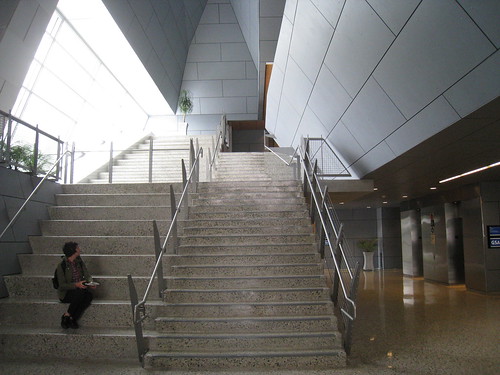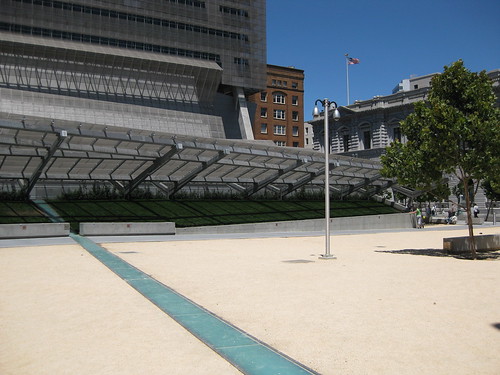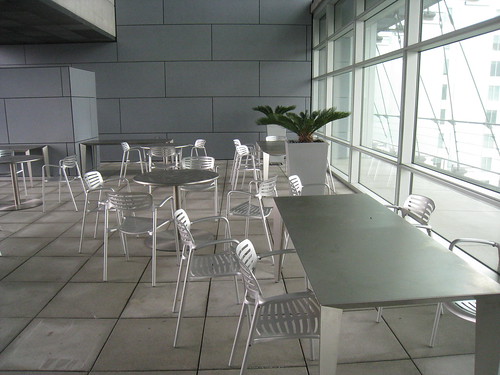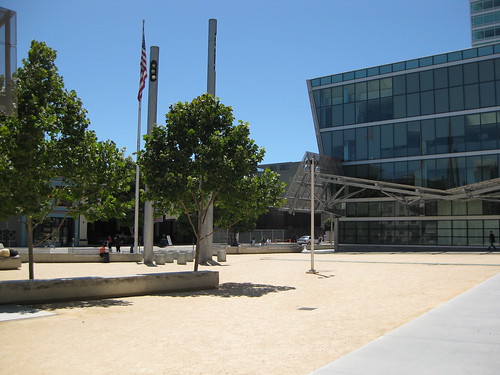This land wasn’t made for you and me
Since opening in 2007, the San Francisco Federal Building, designed by Thomas Mayne of the Morphosis architectural firm, has been internationally renowned as a model for sustainable architecture and green design. Located on the corner of 7th and Mission Street in the South of Market (SOMA) neighborhood, the skeletal grey metal building is visible from blocks away and from ontop of the nearby highway overpass. It stands tall and abstruse, sticking out, literally and visually, from the smaller buildings and offices nearby. On our first official “blogging field-trip, ” Suzanne Stein, Eric Heiman, and myself conducted our own self-guided tour of the federal building to see what exactly all the hype is about.
The pamphlets given to us to accompany our self-guided tour boasted the building’s highly integrated green design: it was built with materials with low or zero toxicity, consumes less than half the power of a standard office building, and incorporates a natural ventilation system. More than sustainable architecture, the interior design of the building promotes health and fitness with a gym facility downstairs and elevators that stop on every third floor encouraging the use of the staircases to get to one’s destination. Another highly regarded aspect of the building’s design is its encouragement of employee interaction through an abundance of social spaces; just beyond each elevator stop is a foyer with benches, plants, and enough space to gather casually or have a small business meeting. Large staircases have the ability to function as informal seating areas and the outdoor Skygarden has tables and chairs where employees can eat lunch and take in the view of the city stretching beyond SOMA to Visitacion Valley and Bayview Hunter’s Point.

A blogger in an unnatural environment. Taking advantage of the informal social space in the lobby of the SF Federal Building.
While no one can argue that the San Francisco Federal Building is not a model for sustainable architecture, a poster in the lobby of the building led us to believe that there may be some discrepancies among the intention and function of the space. The poster reads, “What do you think of the new federal building?” and includes a questionnaire for employees to voice their opinion. Word on the street is that one such discrepancy is the difficulty in regulated temperatures through the natural ventilation system, resulting in employee’s opening the windows for air and watching as their paperwork is swept us by the breeze and drifts down to 7th Street below.
As impressive as the building was, there was some disconnect between what I was reading on the official pamphlet handed to us by the security officers and the experience of walking through the space myself. Every designated “social space” we passed through—the Skygarden, staircases, lobbies, foyers seemed to be missing one integral aspect: people. Every bench, chair, and large accommodating step was empty. There was barely even a trace of people, let along convivial, impromptu exchanges. Granted it was mid-day on a Tuesday (one of the only times designated for self-guided tours) and people were probably behind the heavy gray doors marked “Employees Only” tucked into cubicles and hard at work for the Department of Labor or the Department of Health and Human Services.
Yet that eery sense of absence followed us as we took our field trip outside to the public plaza sprawled out in front of the building along Mission Street. Along the sidewalk is a cluster of concrete cylinders and rectangles that simultaneously serve as protection against car bombings and as benches for those waiting at the nearby bus station or others in need of a temporary resting place. Rather than grass or concrete, the plaza is made of a decomposed granite, a material that allows rainwater to absorb back into the ground rather than running into the sewer system. (A material that is indeed environmentally friendly but rather unwelcoming). In the midst of this strange environment is an old-fashion light post that, upon closer examination, is actually a security camera tracking the activity, or lack thereof, in the plaza. The small patches of grass that are included in the outdoor plaza are pushed back towards the building and tucked underneath a hovering overhang. With the exception of the occasional person passing through, the public plaza was much like the spaces designed for social interaction inside the federal building: without people.
Back in March 2007 when the federal building first opened it was revered by The New York Times Architecture Review in an article entitled, “More Openness in Government (Offices, that is)” written by Nicolai Ouroussoff. Ouroussoff explains the intention of the public plaza, stating that “despite the high level of security the building demands, the architect forged a rich hierarchy of public zones […] a cafe anchoring the southeast corner of the site will give government workers a chance to mingle with the masses at lunch hour.” The disconnect between the intention and my observations of the use of the space were startling: Where were the government workers? Where were the masses? Where was the mingling? The perimeter of the plaza was lined with people taking advantage of the concrete benches, the plaza itself was empty and even desolate in the context of the hustle and bustle of the SOMA neighborhood. Now, I’m not expecting picnic tables or barbeque pits (although, the idealist in me questions why not) but it was perplexing to me just how extremely unwelcoming the space was, particularly within a neighborhood that is predominately warehouses and storefronts and has a very active public presence. SOMA could certainly use a stretch of public space or even a patch of grass.

Cement cylinders near the sidewalk of Mission Street protect the Federal Building against attacks made by car.
Yet, that is exactly it—the land that Mayne’s federal building was constructed on is not public land. It is owned by the federal government and therefore the government of San Francisco (let alone its residents or SOMA neighbors) had no say in the design or use of the space. An explanatory text on the website assures that the building was designed to empower the “local and regional community with a sense of ownership” of this federal propety. This text continues, stating that the San Francisco federal building is “a functional and symbolic manifestation of government that people sustain through exercising their freedom to physically take control of it.” Yes, the ability to peruse the halls and examine the shiny and meticulous details of the interior space during the designated self-guided tour time period was appreciated, but I wonder about that disconnect between intention and actual function of the space, specifically for the public plaza, that in my opinion does little to consider or welcome its public. I wonder if the language used to describe the federal building is in a way a prop, much like the feeling of those lobbies—full of potential, yet empty—that moves in the direction of something while never intending to achieve it.




Comments (4)
I often walk past the Federal Building on my way to work at Electric Works. Although I was initially excited about the green intentions of the building, I often found the plaza empty and bereft of any feeling of life. To animate the space, on Earth Day, 2008, I presented “The Last Dance.” The ecological footprints of 48 nations were arranged on the plaza. It was especially lively when the children from the local day care center came to dance.
http://www.flickr.com/photos/7950911@N04/
Each footprint, cut from recycled carpet padding, represented the quantity of resources used by that country. Inspired by dance instruction charts, the footprints exemplified the disparity in a fun way; that we are all need to watch our steps and that we all are dancing together; that we are all partners on this planet but, some of us have way bigger feet.
To view the video
http://www.youtube.com/watch?v=nNjYMWmkKIc&channel=judithselby
Anu, This is an excellent question. While I’m not an expert in this area, I immediately thought of a project by Tulane City Center in New Orleans that I will share in another post so as to hopefully generate some conversation in response to your question – especially for the Bay Area.
I’ve never been inside, but the street-level space during the day is a strange wasteland. It’s the kind of contemporary design that probably looked good in the renderings. The reality is not as nice, the only evidence that it’s being used is that grassy incline is perfectly designed to capture blowing newspapers and trash. After dark it should be avoided, as there are drug addicts hanging out, yelling threats at pedestrians.
I wonder what it is that breeds such a coldness in a lot of green architecture. Your point of view seems to resonate with the critique of New Orleans’ Make It Right houses in an earlier post – that design, however accomplished, cannot make up for a loss of human quality. Are there any good examples of humanizing green building that you can point to for comparison?